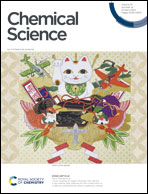Phosphorescent acyclic cucurbituril solid supramolecular multicolour delayed fluorescence behaviour†
Abstract
Organic photoluminescent macrocyclic hosts have been widely advanced in many fields. Phosphorescent hosts with the ability to bind organic guests have rarely been reported. Herein, acyclic cucurbituril modified with four carboxylic acids (ACB-COOH) is mined to present uncommon purely organic room-temperature phosphorescence (RTP) at 510 nm with a lifetime of 1.86 μs. Its RTP properties are significantly promoted with an extended lifetime up to 2.12 s and considerable quantum yield of 6.29% after assembly with a polyvinyl alcohol (PVA) matrix. By virtue of the intrinsic self-crimping configuration of ACB-COOH, organic guests, including fluorescence dyes (Rhodamine B (RhB) and Pyronin Y (PyY)) and a drug molecule (morphine (Mor)), could be fully encapsulated by ACB-COOH to attain energy transfer involving phosphorescent acyclic cucurbituril. Ultimately, as-prepared systems are successfully exploited to establish multicolor afterglow materials and visible sensing of morphine. As an expansion of phosphorescent acyclic cucurbituril, the host afterglow color can be readily regulated by attaching different aromatic sidewalls. This study develops the fabrication strategies and application scope of a supramolecular phosphorescent host and opens up a new direction for the manufacture of intelligent long-lived luminescent materials.

- This article is part of the themed collection: 2024 Chemical Science HOT Article Collection


 Please wait while we load your content...
Please wait while we load your content...